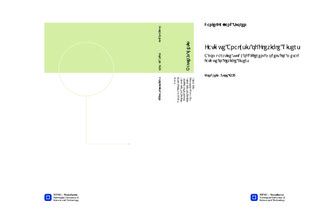| dc.description.abstract | This thesis used different methods to model and predict the fatiguefrom wave loads on the tensile armor layers in a flexible riser in thebending stiffener area. The additional aim of the thesis was to givethe reader an understanding of flexible pipes and risers, and presentthe necessary theory to understand and complete a dynamic analysisof riser with the finite element method, and how to do lifetimepredictions from irregular time series.Different methodologies exist for fatigue calculations for risers. However,the general approach is to use the wave response from a globalriser model, and to apply this to a local model which has a moreaccurate representation of the pipe?s cross-section. The actual fatiguecalculations are done using a SN-curve and Miner sum. Thevariations of the different methods lie in how the models are made,what kind of wave loads the global model is subjected to, and whatloads are used and how these loads are transformed in to the localmodel.The scenario was a new field development close to the Enchova fieldlocated in the Campos Basin off the Coast of Rio De Janeiro. Thisfield will be developed with a turret moored floating unit with lazywaveriser configuration at a water depth of 125 meters. The systemwas modeled with simple tubular elements given the pipe?s bendingstiffness in slip. An irregular wave analysis using the local wave dataiiwas conducted.The transformation of the global time series was done using the Rainflowmethod. The range spectra were divided into 40 bins. Threedifferent local models were made in BFLEX. The first model, M1,was a stub, just a representation of the pipe?s cross-section. Thisis a known approach in the industry. The two last models, M2 andM3, were full sized representations of the bending stiffener, whichwere submitted to axial and lateral loads by decomposing the tensionwith the riser?s hang-off angle. This approach is less used. M2and M3 used different types of elements. Their difference is in theway the tensile armor layer is represented.M2 and M3 have shown to give a less conservative result than M1.This can be understood from the fact that M2 and M3 give a morerealistic representation of the load history. They capture other effectsas well, like for instance the interaction between the pipe andthe bending stiffener (BS) at the BS-tip.It was shown that the BS was too stiff in the local model, this resultedin an abrupt curvature response at the BS-tip. M2 sufferedthe most to this to this. The fatigue response in M3 was more jaggedalong the riser than the response in M2. A comparison of M3 with amore refined mesh was conducted. This did not give the desired improvement.The jaggedness could be understood from nature of theshear interaction model in ITCODE0, whereas ITCODE31 uses elementarybeam theory after the moment-curvature relationship hasbeen calculated.The M3 model showed a pronounced hotspot damage in the root,iiiwhich was believed being caused by the forced displacement the BSexerted on the pipe seeing that both the pipe and the BS were modeledin the same nodal system. This was tried solved with a contactmodel, M3X, where the BS and the pipe were modeled in independentnodal systems with the contact element, CONT130. M3Xproved itself difficult to converge. In the end a separate load historywas applied to M3X and in addition to M3 to demonstrate this loadhistory also had the same tendencies as witnessed earlier. It wasconfirmed that the element type ITCODE0 has the same issues fora dependent and an independent nodal system, and it was thereforeconcluded that this element model must be revised in the future ifit should be applied in similar fatigue assessments.The use of hang-off angle and full representation of the BS paves theway for a less conservative fatigue assessment than the stub model.The biggest damage found along the length of the BS is 51% lessthan what is predicted from the stub model. However, it must benoted that the too stiff BS could have lead to less motion over itslength since the pipe will get a hinge-like transition over the BS-tipfor the upper threshold of wave responses. Even so, it is reasonableto believe that result for a correctly modeled BS will still give alower estimated damage than what is found in the stub model. Theconclusion is that the hang-off angle approach together with the ITCODE31element is an interesting path to pursue. In addition, thestub model approach could always be conducted as a supportingmodel because of its fast solution time. As such, the already establishedmethod does not necessarily need to be abandoned. | nb_NO |

